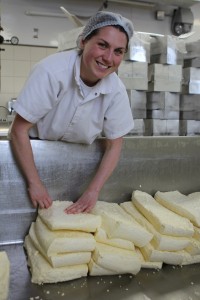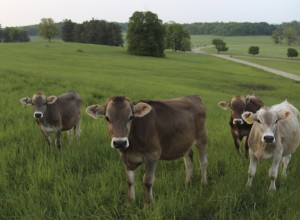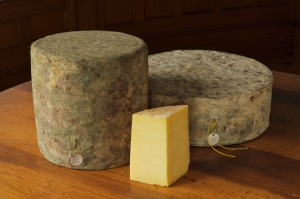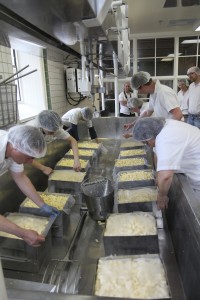By Alyson Barrie and Jonathan Connor
The Big Cheese
 In 2007, while attending UVM, Kate Turcotte began working as a milk hauler at Shelburne Farms, a nonprofit educational farm located near the shores of Lake Champlain in Shelburne, VT. She continued on with an internship during which she learned the cheese making process. After a year at Consider Bardwell farm in West Pawlet, VT, she returned to Shelburne Farms as head cheesemaker. In a state with more cheesemakers per capita than any other, Shelburne Farms stands out as a leader because they are an educational facility. Every day people visit from all over the world to watch them make cheese and to learn about farming and food production.
In 2007, while attending UVM, Kate Turcotte began working as a milk hauler at Shelburne Farms, a nonprofit educational farm located near the shores of Lake Champlain in Shelburne, VT. She continued on with an internship during which she learned the cheese making process. After a year at Consider Bardwell farm in West Pawlet, VT, she returned to Shelburne Farms as head cheesemaker. In a state with more cheesemakers per capita than any other, Shelburne Farms stands out as a leader because they are an educational facility. Every day people visit from all over the world to watch them make cheese and to learn about farming and food production.
How It Began
 A herd of Brown Swiss cows joined the farm in the 1950s and the farmers at Shelburne Farms began to bottle and sell raw milk. Years later, the dairy realized the potential in making a value-added product out of their raw milk. This is when the production of artisan, Vermont Farmhouse Cheddar began at the farm and, as Kate puts it, “Back in the 80s, artisan cheese was this really wild thing.” As wild as the idea may have been at the time, Shelburne Farms now produces over 185,000 pounds of cheese a year.
A herd of Brown Swiss cows joined the farm in the 1950s and the farmers at Shelburne Farms began to bottle and sell raw milk. Years later, the dairy realized the potential in making a value-added product out of their raw milk. This is when the production of artisan, Vermont Farmhouse Cheddar began at the farm and, as Kate puts it, “Back in the 80s, artisan cheese was this really wild thing.” As wild as the idea may have been at the time, Shelburne Farms now produces over 185,000 pounds of cheese a year.
Farmhouse Cheddar
 So what is so unique about Shelburne Farms cheddar? The entire production process takes place on the farm. “If you tried to make this cheese anywhere else, you couldn’t because it’s made from this soil, with this grass, and these cows,” said Kate, “so I think that makes our product really unique.” Milking is done twice a day, morning and night, on the farm. That raw milk is then hauled directly from the dairy to the cheese making facility where it is made into cheese by hand in relatively small batches. Forty-pound blocks of cheddar are sealed, boxed, and placed in coolers at the farm to age from 6 months to 3 years. A small portion of the cheddar is cloth bound and brought to age in cellars at Jasper Hill. However, cave aging is very labor intensive, so the cheesemakers prefer to spend most of their time on making good cheese in the vat. In fact, their Farmhouse Cheddar is not just good cheese; it is excellent cheese that has been winning awards from the American Cheese Society for over two decades.
So what is so unique about Shelburne Farms cheddar? The entire production process takes place on the farm. “If you tried to make this cheese anywhere else, you couldn’t because it’s made from this soil, with this grass, and these cows,” said Kate, “so I think that makes our product really unique.” Milking is done twice a day, morning and night, on the farm. That raw milk is then hauled directly from the dairy to the cheese making facility where it is made into cheese by hand in relatively small batches. Forty-pound blocks of cheddar are sealed, boxed, and placed in coolers at the farm to age from 6 months to 3 years. A small portion of the cheddar is cloth bound and brought to age in cellars at Jasper Hill. However, cave aging is very labor intensive, so the cheesemakers prefer to spend most of their time on making good cheese in the vat. In fact, their Farmhouse Cheddar is not just good cheese; it is excellent cheese that has been winning awards from the American Cheese Society for over two decades.
The Culture of Vermont Cheese
 According to Kate, the success of Vermont’s cheese making can be attributed to the collaboration among cheesemakers. “The reason why Vermont cheese is so successful is because there’s so much collaboration going on,” says Kate. “Cheesemakers have such a great open-door policy. It’s like, if you’re a cheesemaker, then come in, see what I do, see my operations.”
According to Kate, the success of Vermont’s cheese making can be attributed to the collaboration among cheesemakers. “The reason why Vermont cheese is so successful is because there’s so much collaboration going on,” says Kate. “Cheesemakers have such a great open-door policy. It’s like, if you’re a cheesemaker, then come in, see what I do, see my operations.”
Cheesemakers in Vermont are also no strangers to innovation. They are constantly trying to come up with new ways to make consistent, high-quality cheese, while still having it be hand made with raw milk. “It’s an old world tradition with new world technologies,” says Kate, “us evolving happens every single day.”
Shelburne Farms cheese will be featured at the Taste of Vermont Reception at the end of the UVM Food Systems Summit on Wednesday, June 18.
Alyson Barrie and Jonathan Connor wrote this piece for an internship during the spring 2014 semester at UVM.
Photo credits: Kate, Cows, and Cheesemaking by Vera Chang. Clothbound Cheddar by Blake Gardener. All photos courtesy Shelburne Farms and used with permission.










